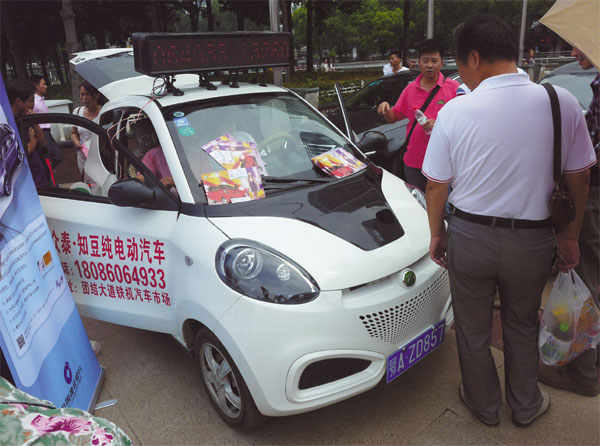The 'catfish' in the market
Low-cost, low-speed EVs have stimulated the growing popularity of new-energy vehicles in China
Apocryphal or not, the story of the Norwegian fishing boat captain who mysteriously succeeded in landing catch after catch of live fish gave rise to the term "the catfish effect".
When faced with the challenge of maximizing his revenue by selling live rather than frozen sardines, this legendary fisherman came up with an ingenious solution, which only came to light after his death.
In order to keep his valuable catch alive, he introduced a catfish to the tank containing his haul. The usurper incited the sardines to swim harder and faster, thus keeping them alive.
The term is now used to describe how existing players in a given market are prompted to improve their products and services when faced with a new and unexpected competitive element.
The appearance of low-cost electric vehicles - or EVs - in China in 2014 had much the same effect. Their market debut left existing players with no choice but to up their game in order to avoid losing market share.
The automotive industry in China has long been eager to explore the potential of EVs and three overriding factors underpin this objective.
The first is the hazardous air quality, for which vehicles, coal and industrial activities are the worst culprits. A number of cities in China have already implemented restrictions on car purchases in an attempt to address the problem, leaving buyers with a stark choice: either participate in an auction or lottery to acquire a car, or choose a new-energy vehicle.
The second factor is China's reliance on imported oil. Given that foreign oil imports accounted for 60 percent of the market in 2014, the use of alternative sources of energy to reduce oil consumption has become a major priority for the government.
The last factor is the government's ambitious goal for the new-energy vehicle market: cumulative sales of 5 million units before 2020.
However, the gap between the government's target and the reality of the market cannot be ignored. In 2013, there were fewer than 8,000 electric cars on the road in China, while during the first three quarters of 2014, only 8,200 units were registered.
To clarify this disparity, we must look at the three principal obstacles that stand in the way of market expansion.
First, the retail price of EVs remains high in China and is beyond the reach of the wider public, in spite of the subsidies available. For example, the BYD E6 would cost a buyer anywhere from 210,000 yuan ($34,257) to 260,000 yuan inclusive of any discounts from subsidies. The same buyer could buy a BMW 3 Series or a Mercedes-Benz C class for roughly the same price.
Second, we cannot escape the lack of charging facilities for EVs in cities across the country.
And finally, the falling oil price now means that the payback period for an EV will exceed that for a traditional car.
Low-cost EVs
However, in the final quarter of 2014, registrations of EVs soared to an unprecedented 23,811 units - a level almost equal to the total number sold over the last two years. So, what prompted this mysterious and sudden spurt of popularity?
The stars of the show have undoubtedly been Geely and Zotye's low-cost EVs. The combined sales of the Zhidou and the Yun 100 by Zotye and the Kandi by Geely came close to 15,000 units in the fourth quarter of 2014, accounting for over 61 percent of the overall market. As their prices are below 60,000 yuan with subsidies taken into account, the vehicles were eminently more affordable than any comparable models on the market.
Both Geely and Zotye tapped into the low-cost EV market by establishing joint ventures with Kandi and Xindayang respectively.
Despite Geely's cooperation with Volvo in the development of medium to high-end models, the company's founder Li Shufu remains convinced that low-speed electric vehicles offer a more practical solution for China, asserting that "low-speed EVs have many advantages. They are suitable for short driving ranges... This type of vehicles can be very small and lightweight, incorporating a smaller battery, which has a reduced battery pack capacity that saves more energy."
Li's vision evolved into a plan of action and, in the process of launching low-cost EVs as part of its joint venture with Kandi, Geely took 37 percent of market share in the closing quarter of 2014.
Sharing and rental
Low-cost EVs, priced to appeal to the mass market, effectively broke through the first barrier that stood in the way of market expansion. Inevitably, the question arose as to how to deal with the remaining two obstacles. The answer was to be found in the car sharing and car rental business models.
Together, Geely and Kandi initiated the Green Car rental service in Hangzhou, providing hourly electric car rental services through a network of over 48 service sites in the city, simplifying the process of rental and return. Rental fees range from 20 to 25 yuan an hour, depending on the model (from two to four seats), which is not too much more than the standard minimum charge of 11 yuan for a taxi. An annual rental service is also available to local residents.
The scheme, dubbed "mini public transport", has essentially made EVs affordable to the mass market, while resolving the charging quandary through its "park and charge" sites.
By the end of last year, close to 10,000 Geely/Kandi electric cars were on the road in Hangzhou. And with other cities such as Chengdu joining the Green Car service operated by Geely and Kandi, a viable solution emerged for the EV market and the remaining barriers were breached in the process.
Looking ahead, as the scheme expands, consumers will benefit from increased opportunities to test-drive EVs before committing to a purchase, while the advantages afforded by such vehicles, such as low running costs and convenient charging through the network of sites, will become increasingly apparent to consumers.
A key point to note is that before Geely took over production, the Kandi as well as the Zhidou by Zotye were classified as "low-speed electric cars". This vehicle type cannot be legally registered since it has no government recognition.
Produced by private manufacturers without an official license, the standard price for such vehicles is usually about 30,000 yuan. In spite of these restrictions and against all the odds, the market flourished to the extent that annual sales of low-speed electric cars exceeded 360,000 units in 2014, rising from a mere 20,000 in 2009. A surge to 1 million units a year by 2020 is well within the realms of possibility.
Low-cost EVs such as Kandi and Zhidou were derived from low-speed electric cars, and they've played the "catfish" role in the market. Based solely on their market acceptance, a move to regulate the market and put in place technical standards should surely be a priority for the government. After all, the new-energy vehicle industry can only sustain itself and thrive through technological advancements and increased affordability.

|
Local visitors are attracted by a Zotye Zhidou electric car at an auto show in Wuhan, Hubei province. With a price of about 40,000 yuan, the low-cost EV has a range of 120 kilometers on one charge, with a top speed of 80 km per hour. Zhou Guoqiang / For China Daily |
(China Daily 04/20/2015 page3)















